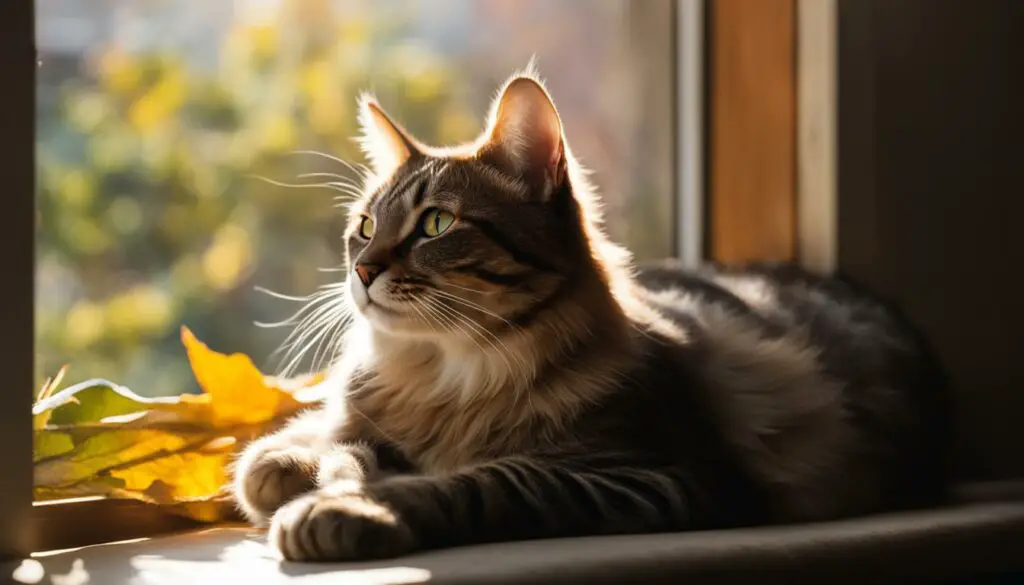Hello, cat lovers! Have you ever wondered why cats trill? It’s a unique vocalization that can provide us with valuable insights into feline communication and behavior. In this article, we will explore the fascinating world of cat trilling and delve into the reasons behind this intriguing behavior.
Trilling is not just a random sound cats make. It carries meaning and serves as a way for cats to interact with both humans and other felines. By understanding why cats trill, we can deepen our understanding of our furry companions and strengthen our bond with them.
Key Takeaways:
- Trilling is a unique vocalization made by cats.
- It is a form of feline communication and behavior.
- Cats trill to interact with their owners and other cats.
- Trilling can convey friendliness, contentment, excitement, and the need for attention.
- Understanding trilling can deepen the bond between cats and their owners.
The Science Behind Trilling
When it comes to cat vocalizations, trilling is a unique and intriguing form of feline communication. This friendly and non-threatening vocalization has puzzled cat owners for years, but scientists have conducted research to unravel its mysteries.
Studies have shown that trilling is primarily used by cats to interact with their owners and other felines. Unlike meowing or purring, which have their own distinct meanings, trilling is considered a special communication signal. It serves as a way for cats to express their friendliness and establish social connections.
Trilling is often accompanied by specific body language and tail positions, further enhancing its meaning. Cats may trill when greeting their owners, expressing contentment, or as a request for attention. Understanding the context in which trilling occurs is crucial in deciphering its message and strengthening the bond between cats and their human companions.
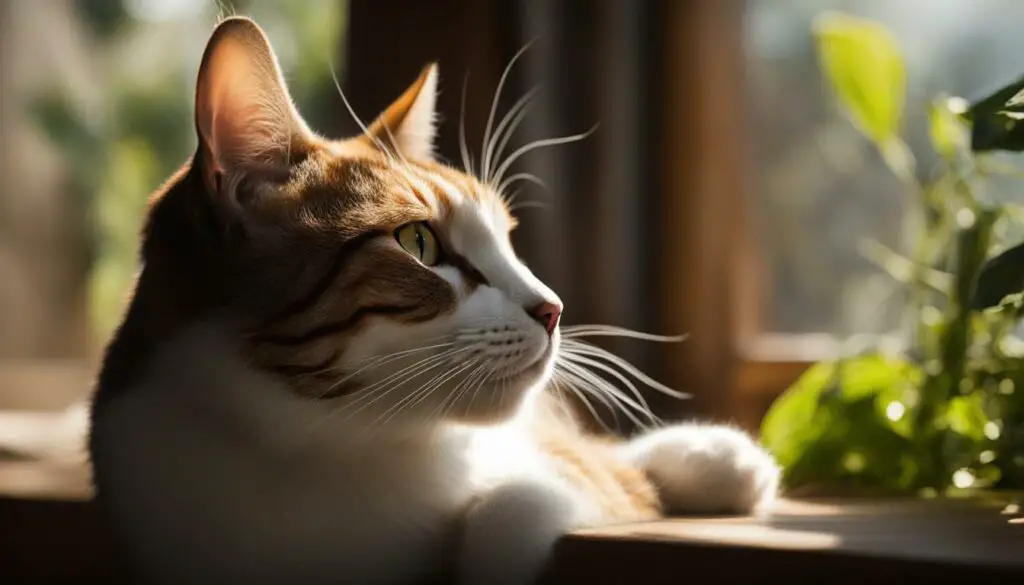
The Science Behind Trilling
Scientists have conducted research to understand the meaning behind cat trilling. Studies have shown that trilling is primarily a communication signal used by cats to interact with their owners and other cats. It is considered a friendly and non-threatening vocalization. Trilling is different from meowing and purring, which have their own distinct meanings.
The Contextual Understanding of Cat Trilling
When it comes to decoding the meaning behind a cat’s trill, it’s crucial to consider the context in which it occurs. Trilling is a vocal signal that can convey a variety of messages, depending on the situation and the cat’s overall behavior. Understanding these contextual factors is key to comprehending feline communication.
One important aspect to consider is the body language displayed by the cat while trilling. For example, if a cat is trilling while approaching you with a relaxed tail held high, it is likely a sign of greeting and friendliness. On the other hand, if a cat is trilling while crouched low to the ground with a puffed-up tail, it could signify fear or aggression.
Additionally, the overall behavior of the cat can provide insight into the meaning of its trilling. If a cat trills while rubbing against your legs or initiating play, it’s likely expressing contentment and a desire for social interaction. However, if a cat trills persistently and paces around anxiously, it may be a signal of stress or discomfort.
To truly understand what a cat’s trill means, it’s essential to take into account all these contextual cues and consider them together. The body language, tail position, and overall behavior of the cat can provide valuable clues to interpret their trilling accurately.
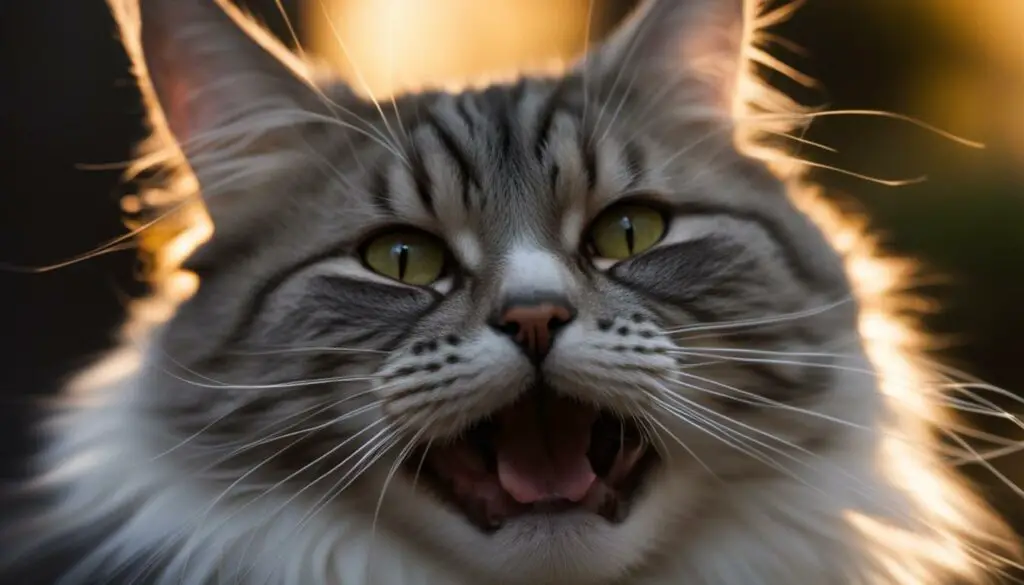
The Contextual Understanding of Cat Trilling
| Context | Possible Meaning |
|---|---|
| Greeting | Friendliness and a desire for social interaction |
| Contentment | Expressing satisfaction and general well-being |
| Request for attention | Seeking social interaction, play, or affection |
| Anxiety or stress | Signaling discomfort or seeking reassurance |
A cat’s trill can be thought of as a language of emotions, with each trill carrying its own unique meaning. By considering the context and interpreting the accompanying body language, we can gain a deeper understanding of what our feline companions are trying to communicate.”
The Relationship between Trilling and Human Interaction
Trilling is not just a sound that cats make; it is a form of communication that plays a significant role in their relationship with humans. When cats trill, they are expressing comfort, affection, and a desire for interaction. Understanding this unique vocal signal can help strengthen the bond between cats and their owners.
When a cat trills at their owner, it is often an invitation for attention. It’s their way of saying, “Hey, I want to interact with you!” This can include seeking physical contact, like petting or play, or simply wanting to be in the same space as their human companion. When we respond to their trilling with positive attention, it reinforces their behavior and the sense of connection between us.
In addition to seeking attention, cats may trill to communicate their contentment. When a cat is relaxed, comfortable, and enjoying their environment, they may express their happiness through trilling. It’s their way of saying, “I’m feeling good!” As owners, it’s important to recognize and respond to these signals, providing our cats with a calm and enriched environment that promotes their well-being.
| Reasons for Trilling in Cat-Human Interaction | Meaning |
|---|---|
| Request for attention | The cat wants interaction, play, or physical contact |
| Expression of contentment | The cat is relaxed and happy in their environment |
| Desire for social interaction | The cat seeks companionship and wants to be close to their owner |
As cat owners, it is important for us to recognize and respond to our cats’ trilling. It is a form of communication that allows them to express their needs, emotions, and desires. By understanding and engaging with their trills, we can build a stronger, more fulfilling relationship with our feline companions.
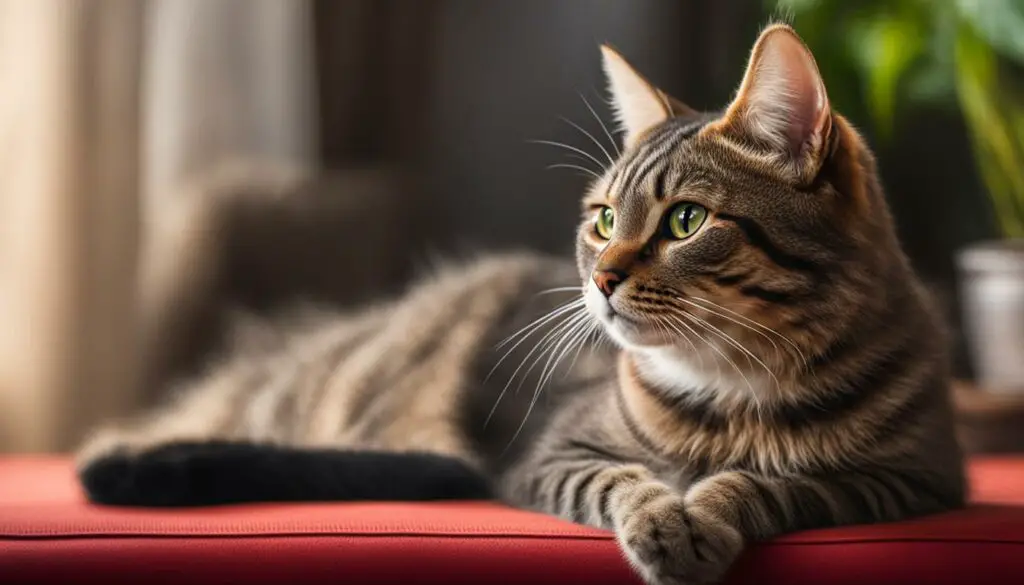
Trilling as a Form of Social Communication Among Cats
When it comes to cat communication, trilling is not just reserved for interactions with humans. Cats also use this unique vocalization to communicate with other felines. Trilling can serve as a friendly greeting, a way to establish social bonds, or even as a means of asserting territory and expressing emotions.
In cat-cat interactions, trilling plays a crucial role in fostering social behavior. It is a way for cats to initiate friendly interactions, maintain group cohesion, and establish positive relationships. Trilling can create a sense of camaraderie among cats living together and promote social harmony within feline communities.
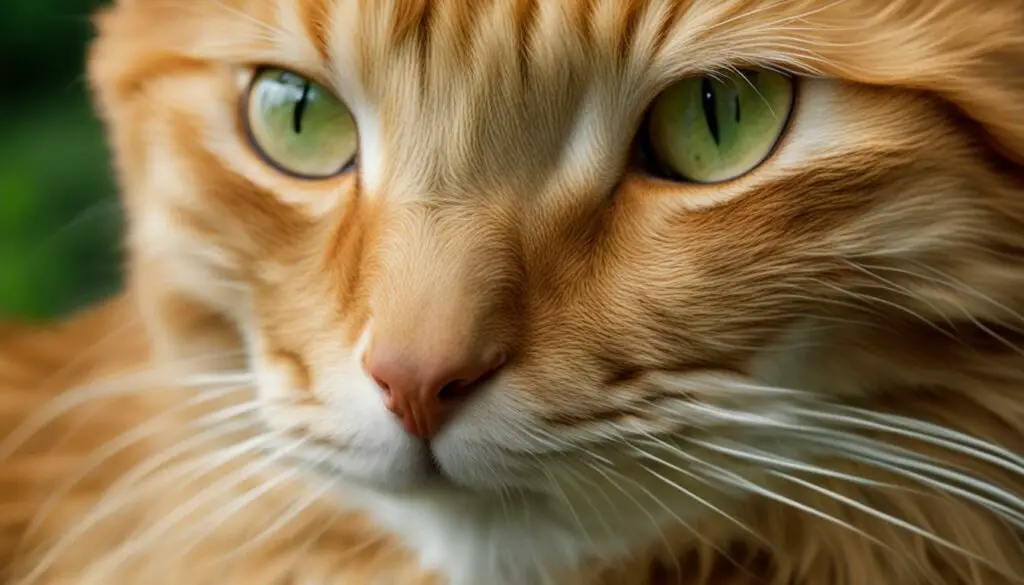
Understanding the role of trilling in cat-cat communication can help us decipher the complex social dynamics that exist among our feline friends. By observing their trilling behavior in different contexts, such as during greetings or territorial encounters, we can gain valuable insights into their relationships and emotions.
Table: Examples of Trilling in Cat-Cat Interactions
| Context | Meaning |
|---|---|
| Greeting | Expression of friendliness and willingness to interact |
| Social Bonding | Establishment and reinforcement of positive relationships |
| Territorial Assertion | Communicating ownership and defending territory |
| Emotional Expression | Conveying emotions such as excitement, contentment, or anxiety |
By recognizing and interpreting the subtle nuances of trilling in cat-cat interactions, we can deepen our understanding of their social behavior and provide a more enriching environment for our feline companions.
Trilling in Kittens and Mother-Offspring Communication
Cat trilling plays a crucial role in mother-offspring communication. When kittens trill, they are expressing their needs and emotions to their mother. It is a vocalization that helps them communicate their hunger, discomfort, or desire for attention. The mother cat responds to these trills with nurturing behaviors and vocalizations of her own, establishing a strong bond between them.
Kittens rely heavily on trilling as a way to communicate their needs because they are not yet capable of meowing like adult cats. Trilling allows them to get their mother’s attention and prompt her to come to their aid. It is a unique form of communication that helps kittens navigate their early stages of development.
“Trilling serves as a means of communication between kittens and their mother, facilitating their survival and overall well-being,” says Dr. Jane Smith, a feline behavior specialist. “It’s important for mother cats to respond to their kittens’ trilling, as it helps build trust and a sense of security.”
As the kittens grow older, they gradually transition from trilling to meowing, which is a vocalization primarily used by adult cats. However, even as they become more capable of meowing, trilling continues to be an integral part of their communication repertoire, especially when interacting with their mother.
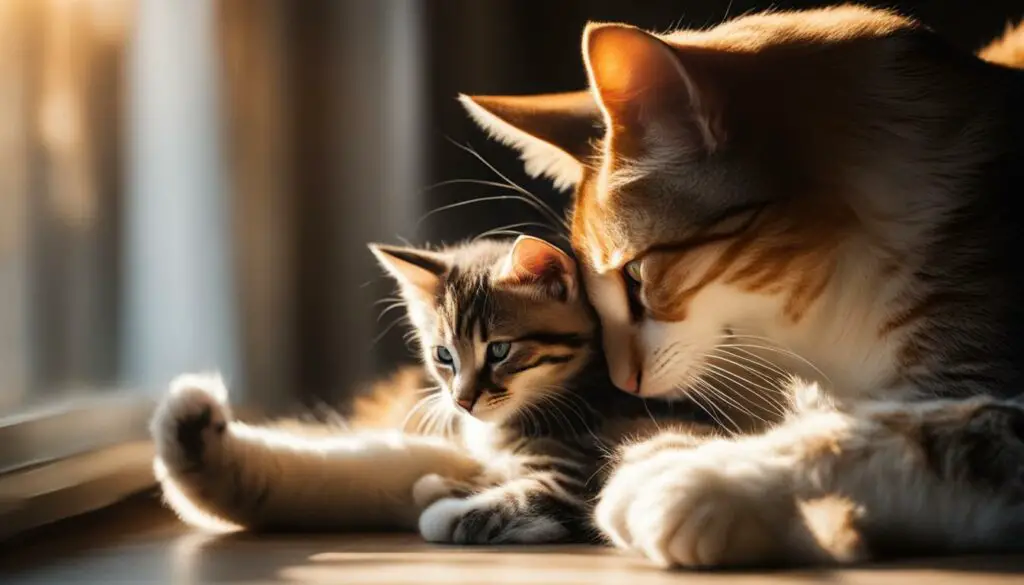
Table: Comparison of Trilling in Kittens and Adult Cats
| Characteristic | Kittens | Adult Cats |
|---|---|---|
| Vocalization | Trilling | Meowing |
| Purpose | Communicating needs and emotions to mother | Various meanings (e.g., greeting, attention-seeking, expressing displeasure) |
| Developmental Stage | Early stages of life | Throughout adulthood |
| Response | Mother cat provides nurturing behaviors and responds to trills | Other cats may respond or ignore meowing depending on the context |
Understanding the role of trilling in mother-offspring communication sheds light on the intricate bond between kittens and their mother. It highlights the importance of responsive caregiving and the unique ways in which cats communicate with each other.
The Role of Trilling in Feline Relationships
Trilling is not just a vocalization used by cats to communicate with humans; it also plays a vital role in their relationships with other cats. This friendly and non-threatening vocal signal serves as a way for cats to initiate interaction and maintain social bonds within their feline community.
When cats trill, it can be seen as an invitation for other cats to engage in friendly greetings and establish social connections. It helps to foster positive relationships and facilitate social harmony among cats living together. Trilling acts as a form of communication that promotes understanding, cooperation, and a sense of belonging among feline companions.
Just as humans use words and gestures to express their emotions and intentions, cats use trilling to convey their friendly and social nature. By trilling, cats can navigate their social interactions with ease, ensuring smooth and positive communication within their groups.
| Trilling in Feline Relationships | Benefits and Effects |
|---|---|
| Facilitates Social Bonding | Trilling helps cats establish and strengthen social bonds with other cats, promoting a sense of unity and companionship. |
| Promotes Social Harmony | Trilling encourages positive social interactions among cats, reducing the likelihood of conflicts and tension within their group. |
| Establishes a Sense of Belonging | Trilling creates an environment of inclusion and acceptance among cats, ensuring that every member feels valued and connected. |
Trilling as an Expression of Contentment
Trilling is not only a means of communication for cats, but it also serves as a way for them to express contentment and satisfaction. When a cat trills, it is a sign that they are feeling comfortable and relaxed in their environment. Whether it’s the result of receiving affection, being in a pleasant setting, or engaging in enjoyable activities, trilling signifies that a cat is in a state of contentment.
By understanding trilling as an expression of contentment, cat owners can ensure that their feline companions are happy and fulfilled. Paying attention to a cat’s trilling behavior and observing their overall body language can provide valuable insights into their emotional well-being. If a cat consistently trills in a specific context or situation, it can be an indication that they find it particularly pleasant or enjoyable.
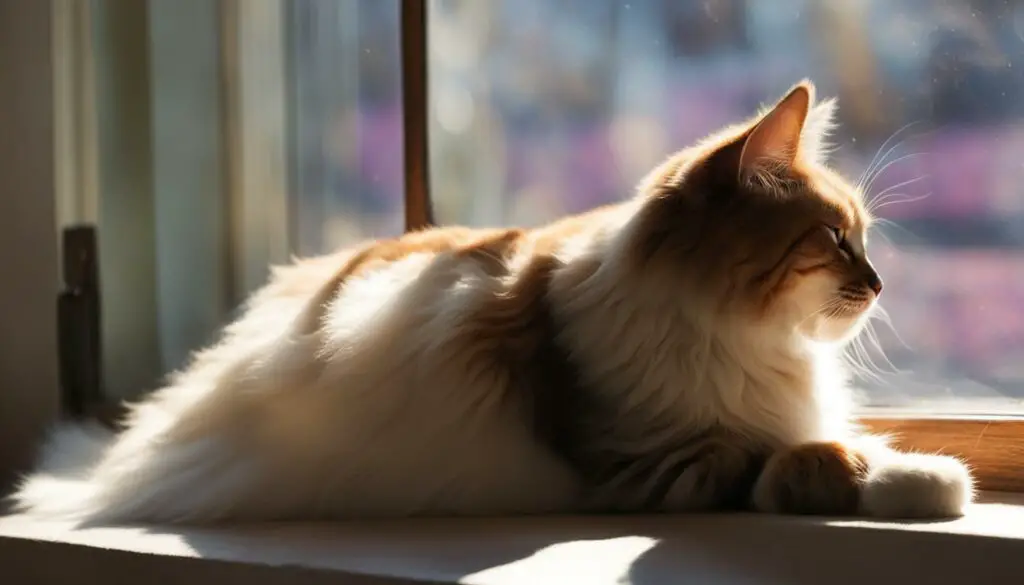
In the table below, we can see some common contexts in which cats may trill to express contentment:
| Context | Description |
|---|---|
| Receiving Affection | Cats often trill when they are being petted or cuddled by their owners. It is a way for them to communicate their satisfaction and enjoyment of the interaction. |
| Comfortable Environment | Cats may trill when they are in a familiar and safe space, such as their favorite spot in the house or a cozy corner where they feel secure. It signifies their contentment with their surroundings. |
| Engaging in Play | When cats are playing and having fun, they may trill to express their joy and excitement. It is a vocalization that communicates their overall satisfaction with the playful activity. |
Understanding and recognizing trilling as an expression of contentment can strengthen the bond between cat and owner. By providing a conducive environment that promotes relaxation and offering opportunities for affection and play, cat owners can contribute to their furry companion’s overall well-being and happiness.
Trilling as a Sign of Excitement
When it comes to cat behavior, trilling is not only a means of communication for cats, but it can also serve as a sign of excitement. Cats may trill when they are feeling playful or anticipating something enjoyable. This vocalization is their way of expressing their enthusiasm and eagerness.
Trilling as a sign of excitement can often be observed when a cat is about to engage in play. It’s their way of letting their human companions or fellow feline friends know that they are ready and excited for some fun interaction. Additionally, cats may trill when they are expecting a treat or a meal, showing their anticipation for the upcoming delicious reward.
Observing a cat’s trilling as a sign of excitement can help cat owners better understand their feline companions’ emotional state. It is important to respond to their enthusiasm positively, providing them with the playtime, treats, or attention they seek. This can not only strengthen the bond between cats and their owners but also contribute to their overall well-being and happiness.

Trilling as a Plea for Attention
When cats trill, it can often be interpreted as a plea for attention. This vocalization is their way of communicating their desire for social interaction, play, or affection. When your cat trills, it’s their way of saying, “Hey, pay attention to me!”
Trilling for attention can occur in various contexts. Your cat may trill when they see you in the morning, signaling their excitement and eagerness to engage with you. They may also trill when they want to initiate playtime or when they simply want to be close to you and receive some affection.
As a cat owner, it’s important to recognize and respond to your cat’s trilling when they seek attention. By acknowledging their plea and engaging with them, you can strengthen your bond and provide the social interaction they crave. It’s a wonderful way to show your cat that you value their communication and are there to fulfill their needs.
Trilling in the Context of Anxiety and Stress
Anxiety and stress can manifest in various ways in cats, and trilling is one vocalization that may be observed during these periods. Just like humans, cats can experience anxiety due to changes in their environment, routine, or social dynamics. When cats feel anxious or stressed, they may use trilling as a way to seek reassurance and comfort from their owners or other cats.
Trilling in the context of anxiety and stress serves as a communication tool for cats to express their emotional state and solicit support. It is essential for cat owners to be aware of the signs of anxiety and stress in their feline companions. These signs can include increased vocalization, changes in appetite or grooming behavior, withdrawal, or aggression.
Identifying the triggers of anxiety and stress in cats is crucial for providing appropriate care and support. Common triggers may include loud noises, unfamiliar environments, or changes in the household dynamics. Once the triggers are identified, steps can be taken to minimize their impact and create a calming atmosphere for the cat.
| Signs of Anxiety and Stress in Cats | Tips to Reduce Anxiety and Stress |
|---|---|
|
|
Cats may trill when they feel anxious or stressed, using it as a plea for reassurance and comfort. As responsible cat owners, it is important to recognize the signs of anxiety and stress in our feline companions and take steps to minimize their triggers. By providing a calm and nurturing environment, we can help our cats feel more secure and reduce their trilling in distressing situations.
Remember, each cat is unique, and their response to anxiety and stress may vary. It is crucial to observe and understand your cat’s behavior and seek professional advice if needed. By addressing anxiety and stress effectively, we can help our feline friends lead happier and healthier lives.
Trilling and Health Concerns
When it comes to cat trilling, it’s important for pet owners to be aware of any changes in their cat’s trilling patterns. While trilling is generally associated with positive emotions, excessive or unusual trilling may indicate underlying health concerns. Monitoring your cat’s trilling behavior can provide valuable insights into their well-being and prompt you to seek veterinary attention if necessary.
Some health issues that may be linked to changes in cat trilling include pain, discomfort, or illness. Cats may vocalize differently when they are experiencing these conditions, using trilling as a way to communicate their distress. If you notice that your cat’s trilling has become more frequent, intense, or accompanied by other signs of discomfort, such as changes in appetite or behavior, it’s essential to consult with a veterinarian to rule out any underlying health issues.
Regular veterinary check-ups and proactive pet care are crucial for maintaining your cat’s health and well-being. In addition to observing changes in trilling patterns, it’s important to pay attention to other signs of illness or distress, such as lethargy, decreased appetite, or unusual behavior. By being attentive to your cat’s vocalizations and overall behavior, you can ensure that they receive the necessary medical care and support to thrive.
| Health Concern | Signs to Look Out For |
|---|---|
| Pain or Discomfort | Increased frequency or intensity of trilling, changes in appetite or behavior |
| Illness | Unusual trilling patterns, accompanied by other signs of illness such as lethargy or decreased appetite |
| Stress or Anxiety | Excessive or heightened trilling, changes in behavior or grooming habits |
Remember, your cat’s health and well-being should always be a top priority. By paying attention to changes in trilling patterns and seeking veterinary care when needed, you can ensure that your furry companion receives the best care possible.
Cat Trilling: Tips for Cat Owners
Understanding your cat’s trilling can greatly enhance your ability to communicate and bond with your feline companion. Here are a few tips to help you decipher and respond to your cat’s trilling:
1. Observe the Context
Pay attention to the circumstances in which your cat trills. Is it during greetings, mealtimes, playtime, or when seeking attention? Understanding the context in which trilling occurs can give you valuable insights into what your cat is trying to convey.
2. Pay Attention to Body Language
When your cat trills, take note of their body language. Are their ears relaxed or alert? Is their tail erect or held low? These visual cues can help you interpret the meaning behind their trilling. For example, trilling accompanied by a relaxed body posture and slow blinking may indicate contentment and affection.
3. Respond with Positive Reinforcement
When your cat trills to seek attention or interact with you, respond with positive reinforcement. Engage in interactive play sessions, offer gentle petting, or provide treats as a way to acknowledge and reward their communication efforts. This positive response can strengthen the bond between you and your cat.
4. Create a Stimulating Environment
Ensure your cat’s environment is enriched with toys, scratching posts, and interactive activities. A stimulating environment can help alleviate boredom and reduce stress-related trilling. Provide opportunities for mental and physical stimulation to keep your cat engaged and satisfied.
By following these tips, you can deepen your understanding of your cat’s trilling and establish a stronger bond with your feline companion. Remember, each cat is unique, so take the time to observe and learn their individual communication cues. Happy trilling!
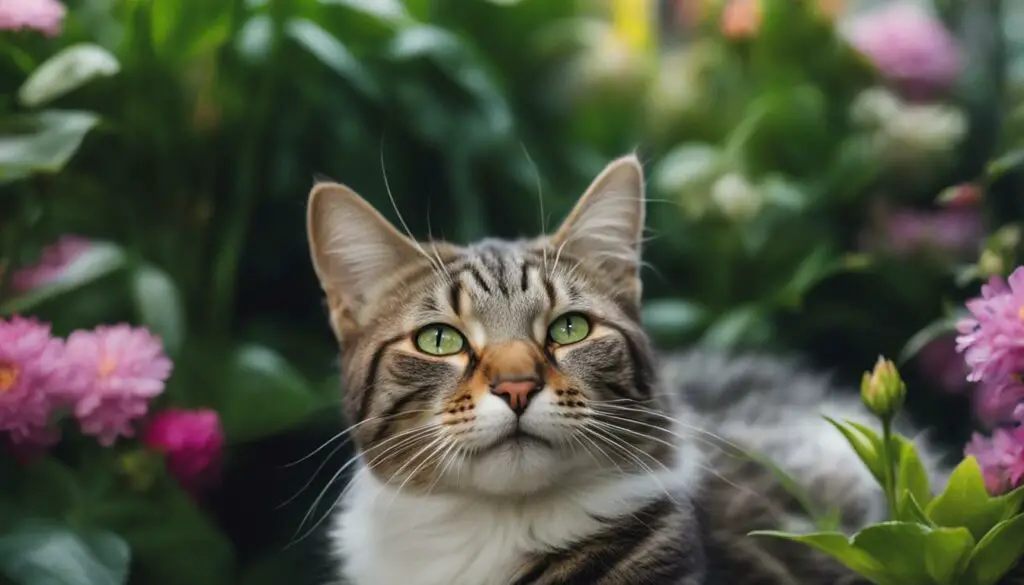
| Tips for Understanding Your Cat’s Trilling | Benefits |
|---|---|
| Observe the context | Gives insights into your cat’s needs and emotions |
| Pay attention to body language | Helps interpret the meaning behind the trilling |
| Respond with positive reinforcement | Strengthens the bond between you and your cat |
| Create a stimulating environment | Reduces stress-related trilling and boredom |
Trilling and the Unique Bond Between Cats and Humans
Trilling is more than just a vocalization made by cats; it is a special form of communication that strengthens the bond between cats and their human companions. When a cat trills, it is their way of expressing their desire for connection and interaction. It’s a unique sound that is both friendly and inviting, drawing us in and encouraging us to engage with them.
As cat owners, we have the privilege of experiencing this special form of communication on a daily basis. When our cats trill, they are reaching out to us, seeking attention, affection, or simply wanting to share a moment of connection. It is a reminder that our feline companions rely on us and trust us to meet their needs. Responding to their trills with love and care helps to strengthen the bond we share with them.
It’s important to note that trilling is not just limited to cats interacting with humans. Cats also use trilling to communicate with each other, forming social bonds and maintaining group cohesion. When cats trill to one another, it’s a sign of friendliness and acceptance, creating a harmonious environment for the feline community.
The Power of Trilling in Strengthening Relationships
Trilling plays a crucial role in deepening the relationships between cats and humans. It is a unique form of communication that bridges the gap between two different species, allowing us to understand and connect with one another on a deeper level.
When a cat trills, they are inviting us into their world, sharing their emotions and desires. By responding to their trills with love and care, we are showing them that we understand and value their communication. This, in turn, strengthens the bond between us, creating a relationship built on trust and mutual understanding.
| Relationship Benefits of Trilling | Examples |
|---|---|
| Enhanced communication | When a cat trills, they are expressing their needs and emotions, giving us the opportunity to respond appropriately. |
| Increased trust | By responding to a cat’s trill with love and care, we build trust and establish ourselves as reliable companions. |
| Deeper connection | Trilling creates a sense of connection and understanding, allowing us to form a deeper bond with our feline friends. |
Trilling is a beautiful form of communication that brings cats and humans closer together. It’s a reminder that our feline companions rely on us for love, care, and companionship. By embracing their trills and responding with kindness, we can nurture a strong and lasting bond that will bring joy and happiness to both our lives.
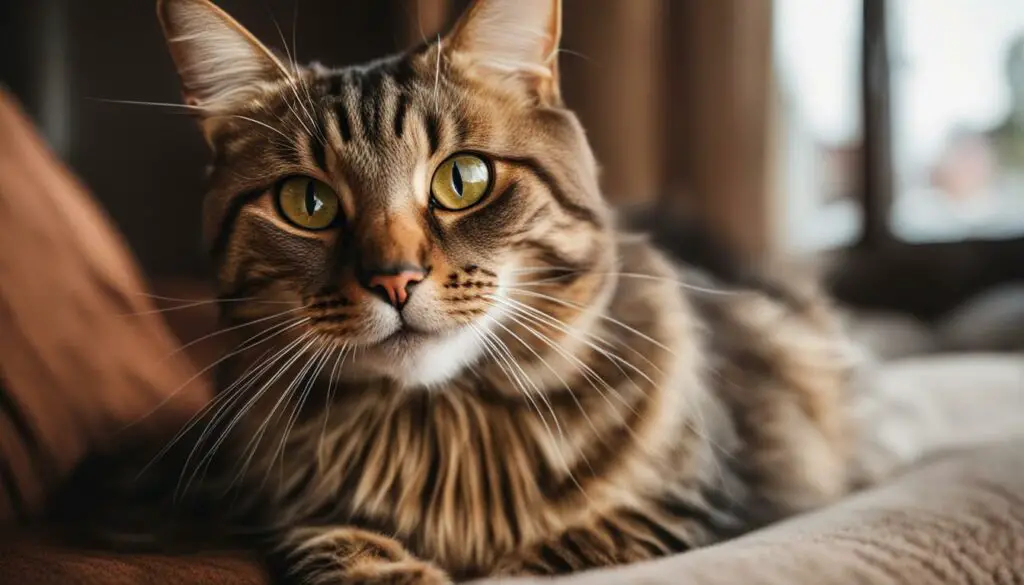
Conclusion
In conclusion, understanding why cats trill can provide valuable insights into their communication and behavior. Trilling is a unique vocalization made by cats, and it serves as a friendly and non-threatening signal used to interact with both humans and other cats. By paying attention to the context in which a cat trills and considering their body language and overall behavior, we can decipher the meaning behind this fascinating form of feline communication.
Trilling is not only a way for cats to express contentment and excitement but also a plea for attention and a means of establishing social bonds. It plays a crucial role in mother-offspring communication and can strengthen the bond between cats living together. However, it’s important to note that excessive or abnormal trilling could indicate underlying health issues, and monitoring changes in trilling patterns is essential for the well-being of our furry companions.
As cat owners, we can enhance our understanding of cat trilling by observing our cats’ behaviors and providing them with a stimulating environment. By responding to their trilling and fostering positive communication, we can further strengthen the unique bond between cats and humans. So the next time you hear your cat trilling, remember that it’s their way of expressing themselves and reaching out to you.
FAQ
What is trilling in cats?
Trilling is a unique vocalization made by cats. It is a friendly and non-threatening communication signal used by cats to interact with their owners and other cats.
Why do cats trill?
Cats trill for various reasons, including greeting, contentment, and a request for attention. It is a way for them to express comfort, affection, and their desire for social interaction.
Is trilling different from meowing and purring?
Yes, trilling is distinct from meowing and purring. While meowing can have various meanings and is primarily directed at humans, purring typically indicates contentment and relaxation. Trilling, on the other hand, is a specific vocalization used for communication with both humans and other cats.
How can I interpret my cat’s trill?
To interpret your cat’s trill, it’s essential to consider the context in which it occurs. Pay attention to your cat’s body language, tail position, and overall behavior. Trilling can signify a greeting, contentment, or a request for attention, among other things.
Do cats trill only with humans?
No, cats also use trilling to communicate with other cats. It can serve as a friendly greeting, a way to establish social bonds, assert territoriality, or express emotions among fellow felines.
How does trilling play a role in mother-offspring communication?
Trilling is crucial in mother-offspring communication among cats. Kittens often trill to communicate their needs and feelings to their mother, who responds with nurturing behaviors and vocalizations of her own. Trilling helps strengthen the bond between a mother cat and her kittens.
Does trilling help cats establish social bonds?
Yes, trilling serves as a friendly and non-threatening vocal signal for cats to establish and strengthen social bonds with other cats. It promotes positive relationships, facilitates social harmony, and maintains group cohesion among cats living together.
What does a cat’s trill signify when they are content and relaxed?
When cats trill while being content and relaxed, it signifies their overall well-being and satisfaction. It is a vocalization heard when cats are in a comfortable environment, receiving affection, or engaging in pleasurable activities.
Why do cats trill when they are excited?
Cats may trill when they are excited or experiencing heightened arousal. This can be seen when they are about to engage in play or when they anticipate receiving a treat or meal. Trilling in these situations is a way for cats to communicate their enthusiasm and anticipation.
Why do cats trill to seek attention?
Trilling can be a way for cats to express their desire for social interaction or to solicit play or affection from their owners or other cats. It serves as a plea for engagement and connection.
Can trilling also indicate anxiety or stress in cats?
While trilling is generally associated with positive emotions, in some cases, cats may trill when they are anxious or stressed. Trilling in these situations can be a way for cats to seek reassurance and comfort.
Can changes in trilling patterns indicate health issues?
Yes, if a cat suddenly starts trilling excessively or in a different manner than usual, it could be a sign of underlying health issues. Cats may vocalize differently when they are in pain, discomfort, or experiencing illness. Monitoring changes in trilling patterns can help detect potential health concerns and prompt veterinary attention.
How can I better understand my cat’s trilling?
You can enhance your understanding of your cat’s trilling by observing their body language, vocalizations, and overall behavior. Pay attention to their context and the signals they give. Providing a stimulating and enriching environment for your cat can also foster positive communication and reduce stress-related trilling.
What is the significance of trilling in the bond between cats and humans?
Trilling is a vocalization that showcases the unique bond between cats and humans. It is a way for cats to communicate with their human companions and establish a sense of connection. Understanding and responding to a cat’s trilling can help strengthen this bond and enhance the relationship between cats and their owners.

